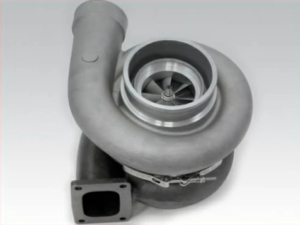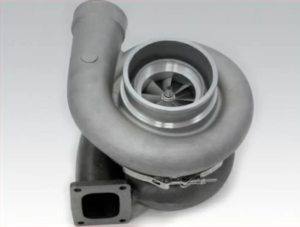
The turbocharger is a critical component in boosting engine performance by forcing more air into the engine’s combustion chambers, increasing power output. Proper disassembly, inspection, and reassembly of the turbocharger are essential to maintain optimal engine performance and prevent damage to this high-performance part. Turbochargers are sensitive components, and improper handling can lead to damage to the impeller, bearings, or seals.
Turbocharger & Related Components for Detroit Diesel Marine Engines
Turbocharger & Related Components for Detroit Diesel 471 Marine Engine
Turbocharger & Related Components for Detroit Diesel 671 Marine Engine
Safety Precautions
- Allow the Engine and Turbocharger to Cool: Turbochargers operate at very high temperatures. Ensure the engine and turbocharger are fully cooled before attempting to remove or inspect it to prevent burns and component damage.
- Disconnect the Battery: Always disconnect the battery before working on the turbocharger to avoid accidental engine start-up.
- Wear Protective Gear: Use gloves and safety goggles to protect yourself from oil, debris, or sharp edges during the disassembly process.
Disassembly Steps For Detroit Diesel 71 Series Inline Engine Turbos (471, 671)

1. Disconnect the Air Intake and Exhaust Connections
The turbocharger connects to both the air intake and exhaust systems, and both connections need to be carefully disconnected.
- Intake Side:
- Loosen the clamps or bolts securing the air intake pipe to the turbocharger. Remove the air intake pipe and set it aside. Inspect the intake pipe for any signs of wear or damage.
- Loosen the clamps or bolts securing the air intake pipe to the turbocharger. Remove the air intake pipe and set it aside. Inspect the intake pipe for any signs of wear or damage.
- Exhaust Side:
- Disconnect the exhaust pipe from the turbocharger’s turbine housing. Use penetrating oil if the bolts are difficult to loosen due to heat and corrosion. Carefully remove the exhaust pipe and set it aside.
- Disconnect the exhaust pipe from the turbocharger’s turbine housing. Use penetrating oil if the bolts are difficult to loosen due to heat and corrosion. Carefully remove the exhaust pipe and set it aside.
2. Disconnect the Oil Feed and Return Lines
The turbocharger requires lubrication for its internal bearings, and the oil lines supplying oil to and from the turbo need to be disconnected before removal.
- Oil Feed Line:
- Loosen the fitting connecting the oil feed line to the top of the turbocharger. Be prepared for some residual oil to leak out, and use a rag to catch any drips.
- Loosen the fitting connecting the oil feed line to the top of the turbocharger. Be prepared for some residual oil to leak out, and use a rag to catch any drips.
- Oil Return Line:
- Similarly, disconnect the oil return line at the bottom of the turbocharger. Cap the open oil ports to prevent contamination during disassembly.
- Similarly, disconnect the oil return line at the bottom of the turbocharger. Cap the open oil ports to prevent contamination during disassembly.
3. Remove the Turbocharger from the Engine
Once the air intake, exhaust, and oil lines are disconnected, the turbocharger can be removed from the engine.
- Remove the Mounting Bolts:
- The turbocharger is typically bolted to the exhaust manifold or a separate mounting bracket. Use a socket wrench to carefully remove the mounting bolts while supporting the turbocharger to prevent it from falling.
- The turbocharger is typically bolted to the exhaust manifold or a separate mounting bracket. Use a socket wrench to carefully remove the mounting bolts while supporting the turbocharger to prevent it from falling.
- Lift the Turbocharger from the Engine:
- Carefully lift the turbocharger away from the engine. Be mindful of its weight and the delicate internal components, especially the turbine and compressor wheels.
- Carefully lift the turbocharger away from the engine. Be mindful of its weight and the delicate internal components, especially the turbine and compressor wheels.
4. Inspect the Turbocharger
After removing the turbocharger, thoroughly inspect its components for signs of wear, damage, or oil leaks.
- Inspect the Compressor and Turbine Wheels:
- Check the compressor (intake side) and turbine (exhaust side) impellers for any damage, such as chips, cracks, or signs of wear. Damaged impellers can severely reduce turbo efficiency.
- Check the compressor (intake side) and turbine (exhaust side) impellers for any damage, such as chips, cracks, or signs of wear. Damaged impellers can severely reduce turbo efficiency.
- Check the Bearings and Shaft Play:
- Gently spin the turbocharger’s shaft by hand to check for smooth movement. There should be minimal play in the shaft—typically within 0.0015 to 0.003 inches (0.038 to 0.076 mm) of radial play. Excessive play may indicate worn bearings or seals that need replacement.
- Gently spin the turbocharger’s shaft by hand to check for smooth movement. There should be minimal play in the shaft—typically within 0.0015 to 0.003 inches (0.038 to 0.076 mm) of radial play. Excessive play may indicate worn bearings or seals that need replacement.
- Inspect the Housing:
- Check the compressor and turbine housings for cracks or signs of oil leakage. Leaks can indicate worn seals or other internal damage.
Reassembly Notes

- Prime the Turbocharger with Oil:
- Before reinstalling the turbocharger, fill the oil feed line with fresh engine oil to lubricate the bearings. This prevents a “dry start” that could damage the turbocharger’s internal components.
- Before reinstalling the turbocharger, fill the oil feed line with fresh engine oil to lubricate the bearings. This prevents a “dry start” that could damage the turbocharger’s internal components.
- Reinstall the Turbocharger:
- Carefully position the turbocharger back onto the engine’s exhaust manifold or mounting bracket. Insert the mounting bolts and tighten them evenly to the manufacturer’s specified torque settings.
- Carefully position the turbocharger back onto the engine’s exhaust manifold or mounting bracket. Insert the mounting bolts and tighten them evenly to the manufacturer’s specified torque settings.
- Reconnect the Oil Feed and Return Lines:
- Reconnect the oil feed line to the top of the turbocharger and the oil return line to the bottom. Ensure that the fittings are securely tightened to prevent oil leaks.
- Reconnect the oil feed line to the top of the turbocharger and the oil return line to the bottom. Ensure that the fittings are securely tightened to prevent oil leaks.
- Reconnect the Air Intake and Exhaust Piping:
- Reattach the air intake piping to the compressor side of the turbocharger, ensuring all clamps and bolts are properly tightened. Reconnect the exhaust piping to the turbine side of the turbo, using new gaskets where necessary to ensure a tight seal.
- Reattach the air intake piping to the compressor side of the turbocharger, ensuring all clamps and bolts are properly tightened. Reconnect the exhaust piping to the turbine side of the turbo, using new gaskets where necessary to ensure a tight seal.
- Check for Leaks:
- After reassembly, start the engine and allow it to run at idle for a few minutes. Check for any leaks around the oil lines, intake, and exhaust connections. If any leaks are found, re-tighten the connections or replace the gaskets as needed.
Inspection Tips

- Monitor for Oil Leaks:
- Regularly inspect the turbocharger for signs of oil leaks around the compressor and turbine housings. Leaks can indicate a failed seal, which may require the turbo to be rebuilt or replaced.
- Regularly inspect the turbocharger for signs of oil leaks around the compressor and turbine housings. Leaks can indicate a failed seal, which may require the turbo to be rebuilt or replaced.
- Check for Shaft Play:
- During routine maintenance, check the turbocharger shaft for excessive play. Worn bearings or excessive shaft play can lead to performance issues and eventually result in turbocharger failure.
- During routine maintenance, check the turbocharger shaft for excessive play. Worn bearings or excessive shaft play can lead to performance issues and eventually result in turbocharger failure.
- Inspect for Cracks in the Housing:
- Check both the compressor and turbine housings for any cracks, especially after long periods of heavy use. Cracks can lead to pressure loss and reduced engine performance.
Turbocharger & Related Components for Detroit Diesel Marine Engines
Turbocharger & Related Components for Detroit Diesel 471 Marine Engine
Turbocharger & Related Components for Detroit Diesel 671 Marine Engine
- Check both the compressor and turbine housings for any cracks, especially after long periods of heavy use. Cracks can lead to pressure loss and reduced engine performance.



 Free US Calls: 1-888-433-4735
Free US Calls: 1-888-433-4735 International: 305-545-5588
International: 305-545-5588